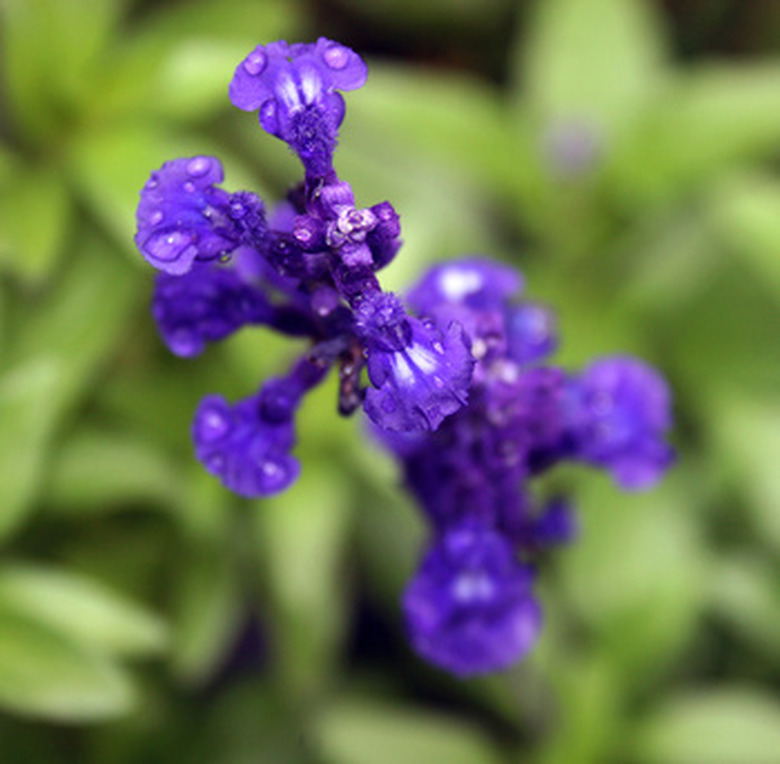Uses For Russian Sage
If you have visions of lavender in your garden, but your poor soil doesn't allow it, Russian sage can fill in. Its small purple flowers and tall, hedge-like presence make it a close stand-in for the real thing. Russian sage is also fragrant, so much so that it attracts butterflies. It stays in bloom most of the summer, so its delicate purple flowers won't wilt and die in the hot sun–which it in fact prefers. Russian sage isn't only used for decorative gardening. It has culinary and medicinal uses and also helps keep pests out of your garden.
Decorative Gardening
Russian sage grows to 3 feet tall. Its stems are tall and straight, so it shines as a border. Its height and vibrant purple colors make it an attractive stand-alone plant, but it also makes a colorful backdrop for smaller flowers in a mixed garden. It grows well up to USDA zone 6 and grows well in soils other plants traditionally find poor, like clay or sandy soils.
- If you have visions of lavender in your garden, but your poor soil doesn't allow it, Russian sage can fill in.
- Its height and vibrant purple colors make it an attractive stand-alone plant, but it also makes a colorful backdrop for smaller flowers in a mixed garden.
Deer and Insect Repellent
The Colorado State University Extension points out that deer do not browse areas heavily populated with Russian sage. Organic gardeners also widely regard the plant as an effective repellent for insects like cabbage worms. Even though it deters some garden creatures, it attracts butterflies, according to Heritage Perennials.
Cooking
Restaurants use Russian sage to garnish dishes. Some chefs use the small purple flowers in salads and deserts. They have a delicate, slightly sweet flavor. Unlike other sage varieties, Russian sage leaves are not edible.
- The Colorado State University Extension points out that deer do not browse areas heavily populated with Russian sage.
- Organic gardeners also widely regard the plant as an effective repellent for insects like cabbage worms.
Medicine
According to Plants for a Future, natural healers use Russian sage in alternative medicinal practices to bring down high fevers. No major studies in the United States confirm this, but it's commonly used for this purpose in India.
Shrubs Go Good With Russian Sage?
Yvonne Cunnington, author of "Basic Gardening" and the Flower Gardening Made Easy website, pairs her Russian sage with staghorn sumac (Rhus typhina "Tiger Eyes"). pair well with Russian sage in all sorts of ways. The rounded, multipetaled rose flowers contrast with the spiky stems of Russian sage, and the warm reds, pinks, magentas and yellows of roses contrast with the cool blue of Russian sage. A white rose would also work well with Russian sage if you also plant other flowers in multiple colors alongside them. P. Allen Smith, author of "Colors for the Garden," likes an expanse of lime green or chartreuse behind purple and blue flowers. He recommends Japanese barberry (Berberis thunbergil), a 2- to 6-foot-tall and equally wide shrub that grows in USDA zones 5a through 10b. "
- According to Plants for a Future, natural healers use Russian sage in alternative medicinal practices to bring down high fevers.
- Yvonne Cunnington, author of "Basic Gardening" and the Flower Gardening Made Easy website, pairs her Russian sage with staghorn sumac (Rhus typhina "Tiger Eyes").
References
- Heritage Perennials: Perovskia Atriplicifolia
- Plants for a Future: Perovskia Atriplicifolia
- The New Sunset Western Garden Book; Kathleen Norris Brenzel, editor
- Flower Gardening Made Easy: Russian Sage – Terrific Long-Blooming Blue Flowers
- Fine Gardening: Caryopteris × Clandonensis "First Choice" (Blue Beard, Blue-Mist Shrub)
- Colors for the Garden; P. Allen Smith
